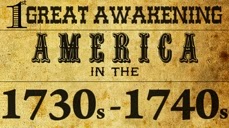By James Wilson
The American colonies were the fruit of an English revival rejected by the English people and government. The Puritan vision was of a reformed and re-vitalized England brought about through enthusiastic embrace of the Living God. When the Puritans found themselves despised they came to America and set up a culture of that embrace, believing that when those they left behind saw what God did with them they would hunger for the same. The Pilgrims were more radicalized, but their sense of a city on a hill – observed and hungered for – was just as strong. Yet revivals do not form nations; awakenings do.
The first American Great Awakening rocked the Atlantic seaboard in the 1730s and 40s. It began in the pastures of the Connecticut River Valley as the Holy Spirit ignited preaching with signs and wonders. The Spirit drew hundreds of thousands and the emphasis was on receiving and growing a relationship with God in the Person of His Son. These relationships were as intimate as they were dynamic – and uncomfortable for observers. People coming under the Spirit would frequently cry out, weep, laugh, and convulse on the ground. Fruit was that jails tended to empty as people became less inclined to commit crime, families tended to come together as parents became parents and spouses re-committed to loving and faithful marriage. Colonists saw themselves as Americans rather than British ex-patriates. This social and spiritual cohesion enabled Americans to fight a revolutionary war and write a Declaration of Independence and Constitution.
Just as the first Great Awakening formed an American identity, the second formed an American character in which concerted efforts from barn raisings to spanning a continent to walkers on the moon were simply viewed as the American way. Public schools and social welfare movements were its creations. It birthed a commitment to live in freedom for all – the commitment that abolished slavery and struggled for another century to make manifest what they had mandated.
Revivals often lead to Awakening – when they are not managed to death by the very people who triggered them – but revivals are confined to the Church while awakenings hit the streets and transform cities; they often begin outside institutional churches. The charismatic revival of the sixties featured thousands being healed, renewed in their faith and – in many cases – coming into a relationship with Jesus for the first time. But the cities at its heart – Los Angeles and Seattle – were no different after the revival than before it. The Toronto Blessing that rocked churches all over the world is a formative influence on my own character and approach to God – but Toronto remains the city it was pre-1994. Many want to hail the Azusa Street Revival of 1906 as an awakening, but that revival was destroyed by the failure of leaders to confront the racism that strangled it. Los Angeles remained as it had always been, only bigger and richer as oil and entertainment industries came of age there.
It can be argued – and I would – that Azusa Street was resurrected in the charismatic renewal triggered by Dennis Bennett. This revival led into the Jesus People, which is the third Great Awakening in America.
The Jesus People began outside the Church – on the beaches of California and Oregon. It began with drugged out hippies who had radical encounter with Jesus and took Him along wherever they went. They birthed modern worship music, a renewed emphasis on families, and a normalized view of signs and wonders on city streets. The modern recovery movement and the Messianic movement among Jews are from the Jesus People. The idea of vision preceding product in the business world is fruit of this movement, as is the movement for reconciliation with people groups and across all dividing lines. Jesus People picked up where Azusa left off and got it right re racial integration.
I do not mean to imply the Awakenings are cool and revivals are not. Both have a place of honor in the Kingdom of God. But the one tends to be a fuller manifestation of the larger Kingdom while the other is more instrumental to it. Awakenings tend to be rejected by the larger Church until the fruit comes into the bin while revivals tend to dramatically stir the Church – or at least the streams in which they come. The kiss of death for either is the urge to manage and tame them by leadership. But the kiss of life from the Lord comes – always – in response to a season of repentance from that cross-section of the Body hearing the promise of the Lord without seeing its manifestation.
James A. Wilson is the author of Living As Ambassadors of Relationships and The Holy Spirit and the End Times – available at local bookstores or by e-mailing him at
praynorthstate@charter.net




